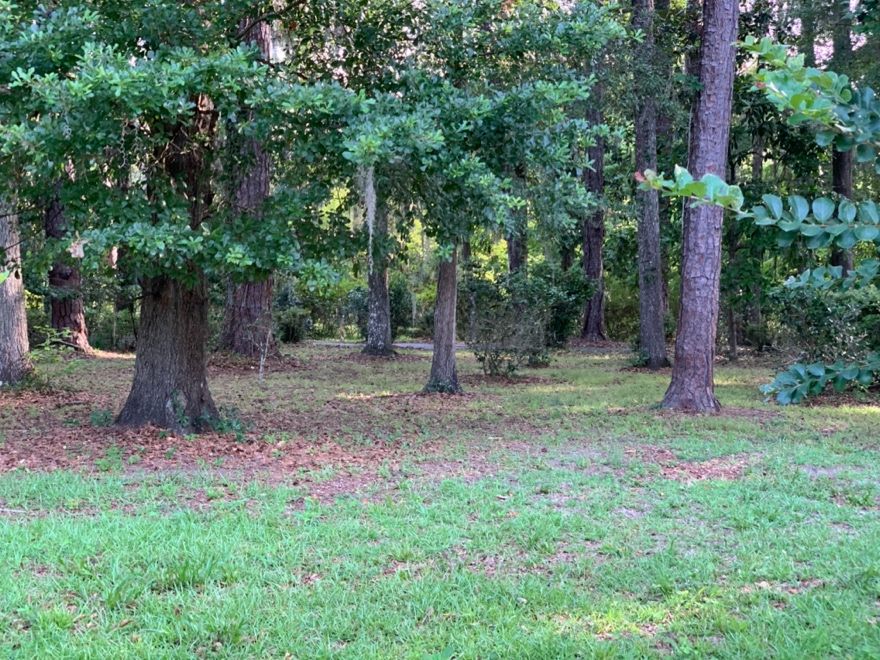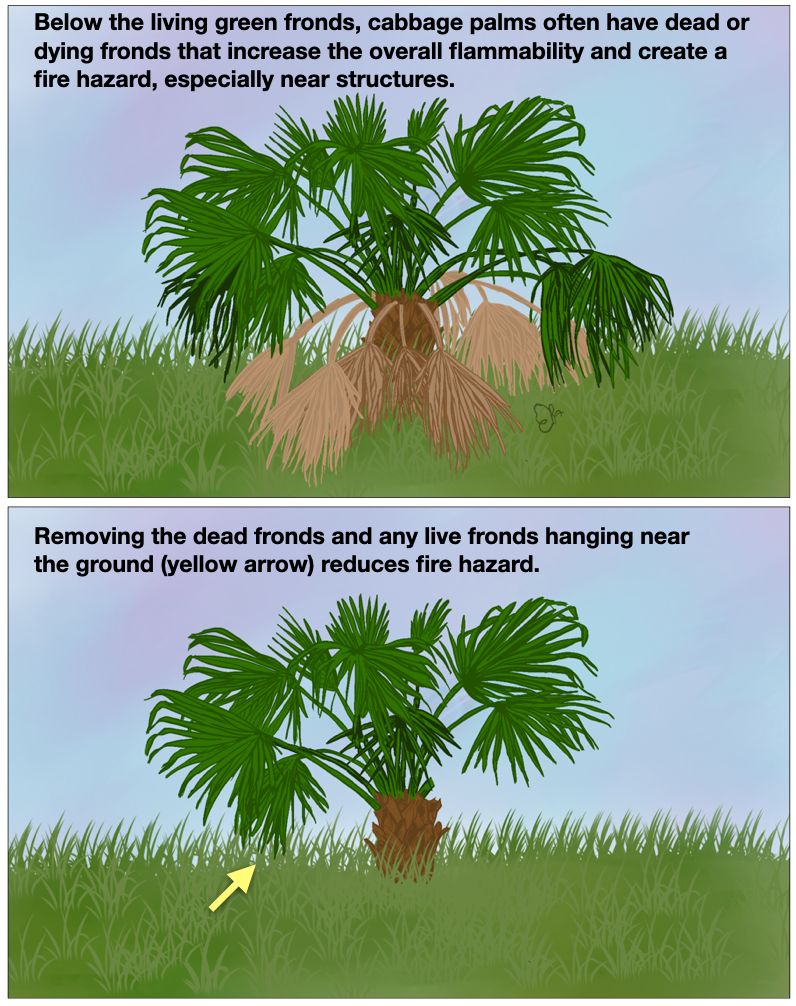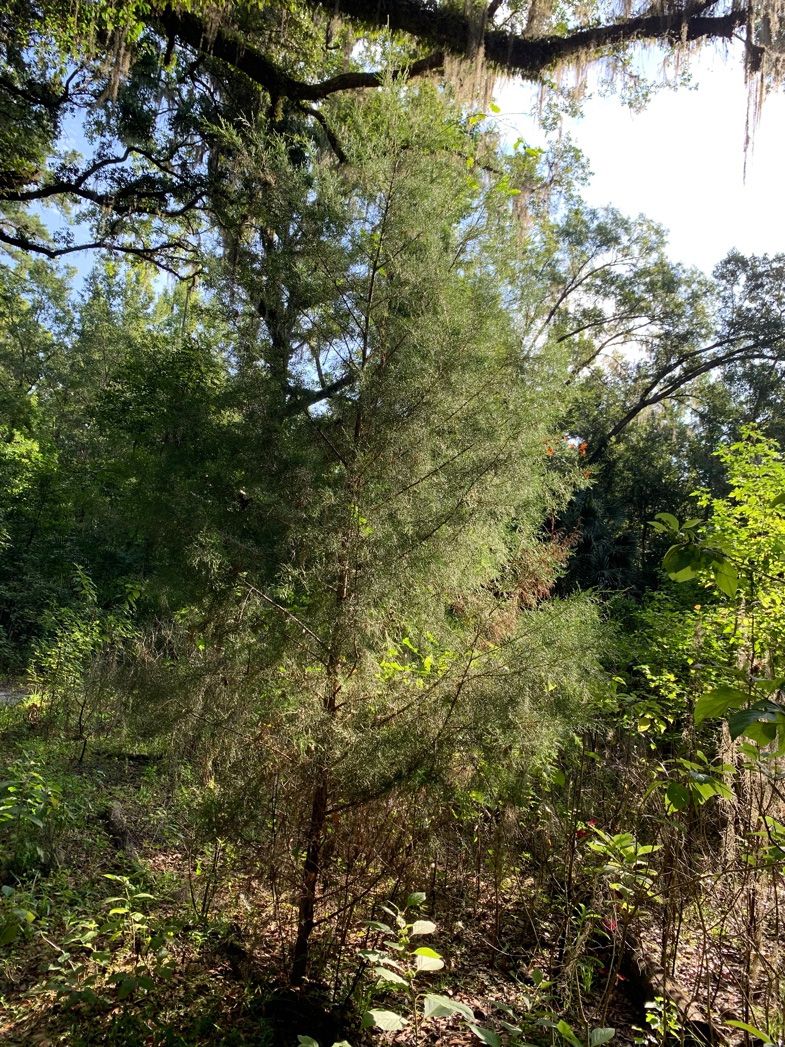Fires are an essential component of southeastern United States landscapes, where natural fires have shaped and maintained the landscape. Today, well-trained professionals use prescribed fires to mimic the positive effects of wildfires under safe, planned conditions. Prescribed fires help reduce the probability and intensity of destructive wildfires by reducing the buildup of flammable vegetation. The purpose of this publication is to provide basic information to homeowners, natural resource managers, and land developers on reducing wildfire risk in the wildland-urban interface.
Wildfires are one of the most serious and publicized challenges facing forest management. They can affect human health and cause costly damage to homes, businesses, timber, and tourism. Wildfires often receive a lot of media attention that can influence overall perceptions of fire and discourage the acceptance of prescribed fire. It is essential to understand that prescribed fires, in contrast to wildfires, are carefully planned and lit in a designated area by teams of trained professionals. Prescribed fires have many benefits to plants, wildlife, and humans (Diaz 2012; Long and Oxarart 2017).
Managing wildfire in the wildland-urban interface (WUI) is especially challenging. Although some landowners and interface residents understand the importance of fire and are willing to support its use, they are concerned about the risk to structures, smoke, and other potential outcomes. For instance, there are often limited days with appropriate weather, and predicting when weather, fuels, and winds will be suitable for burning can be difficult. When lighting prescribed fires, there are also concerns with liability issues, the potential harmful impacts of smoke on human health and driving safety, and the fragmented quality of many forests (Monroe 2002; Brose and Wade 2002; Long and Oxarart 2017; Parajuli et al. 2020).
Despite challenges, fires play an important role in maintaining most forested areas in the southeastern United States. We need to learn to live with fire because these ecosystems depend on fires to stay healthy, reproduce, and support native diversity (Dixon et al. 2019). Creating firewise communities allows fires to be safely lit in the WUI, keeping our southern landscapes healthy.
Fuel Reduction
The best way to minimize the risk of fire damage to a community is to reduce fuels around structures and along firebreaks (Figure 1). Fuel reduction methods include mechanical, prescribed fire, herbicide, and animal grazing.

Credit: Raelene M. Crandall, UF/IFAS
Mechanical thinning removes trees, usually targeting low-value species and trees with small trunk diameters. It can reduce fuel loads and ladder fuels in the understory. Manual thinning with loppers or small, safety-enhanced chainsaws is sufficient in small stands, especially those close to homes. In large or commercial timber stands, thinning is usually achieved through some combination of mechanical and manual processes with bush hogs or heavy-duty choppers, chainsaws, loppers, and brush cutters. This equipment can be difficult and dangerous to operate, so caution should be exercised in recommending its use. Stand thinning can evoke ideological opposition from landowners concerned that active management degrades forest health or reduces regional esthetics. Stand thinning is also expensive if there is no available market for the wood extracted during the thinning.
Prescribed burning is the planned lighting of ecologically appropriate fires by trained professionals under safe weather conditions to achieve specific goals, such as reducing hazardous fuel loads and keeping fire-dependent communities healthy. About five to six million acres of non-industrial private land are burned with prescribed fire in the southeastern United States each year (Melvin 2022). Prescribed burning requires a great deal of skill, training, experience, and education, along with the equipment and resources for safety and success. Certification, burn plans, and permits are required by state forestry agencies.
Prescribed burning receives some opposition from WUI landowners and communities because there is a lot of preparation needed before the burns and because of health and safety concerns during burns. For instance, landowners might have to do extensive site preparation to prevent non-native invasive species from spreading after a burn. Controlling seed sources and resprouting can be both time-consuming and expensive for landowners. Furthermore, natural resource managers must work with interface communities before and after a burn to address concerns about smoke impacts, including air quality and low visibility on roadways. They also work with communities to make sure waterways and wildlife are not negatively affected.
In addition, prescribed burning can be expensive even though it costs less than other methods. You need trained professionals and specialized equipment to conduct prescribed burns, which can be costly, especially when in short supply. Burning costs an average of $32 per acre with higher costs associated with burning at the WUI (Maggard and Barlow 2021). Burning in urban areas is more expensive than in rural areas because more preparation and interaction with the public are required. Liability concerns greatly restrict burning in some WUI areas. Some states, including Florida, have passed laws that lower the liability of individuals conducting prescribed burns, as long as they have taken a training course and become certified as prescribed burn managers (Florida Forest Service 2019).
Herbicides are another management tool to reduce fuel loads. Their primary benefit is fuel reduction over time. Although they are cost-effective and relatively low-risk to the environment if applied correctly, research shows herbicide use is often not accepted by the public because of the perceived effects on forest health (Monroe 2002). Herbicide applications must be timed to avoid increasing the risk of fire by killing plants that dry more quickly after they are dead. For example, herbicide application before the wet season when fuels are more likely to be wet may reduce wildfire risk. Herbicides application before the dry season may increase the short-term risk of fire by creating additional fuels. Look up local regulations on herbicide use before choosing this option, as several herbicides are regulated by state law for use in forest ecosystems.
Thinning, burning, and herbicides can each be used on their own or together to maintain forest health. The best way to use them depends on forest conditions and safety goals.
Animal grazing uses goats and other animals to reduce and control vegetation that might serve as ladder fuels that endanger structures. Grazing fields placed around or adjacent to communities can function as large fire breaks that significantly reduce the risk of wildfire spreading into a community. Fenced areas can accommodate cattle, horses, sheep, or goats that will maintain a pasture-like fire break. However, some local ordinances do not allow domestic livestock in residential areas.
Firewise Communities
In fire-dependent ecosystems, the question is not whether a fire will burn but when. Communities in fire-prone ecosystems need a landscape-level firewise plan to minimize the risk of wildfire damage. Community preparation can include land-use planning and policy as well as training and equipment for landscape management (Godwin 2014). Large communities with fire departments should work with local forest and fire agencies to gain the skills and equipment necessary to fight wildfires. Communities that work together and plan accordingly can protect life and property values while sustaining an ecosystem that depends on fire.
Some areas are less likely to burn during a wildfire and thus serve as important barriers. For example, large open spaces like open parks, golf courses, and agricultural districts could separate communities from forested areas that are more likely to experience a wildfire. To maintain reduced fuel, these areas will likely need some maintenance, such as mowing high-fuel areas on golf courses or tilling agricultural fields. Zoning codes and community land-use plans should ensure that these areas are not developed with houses or densely planted with trees (National Interagency Fire Center 2005; National Firewise Organization 2005; Southern Center for Urban-Wildland Interface Research and Information 2004). Helpful information for preparing firewise communities is available from the National Fire Protection Association (https://www.nfpa.org/Public-Education/Fire-causes-and-risks/Wildfire/Firewise-USA) and the Florida Department of Agriculture and Consumer Services (https://www.fdacs.gov/Forest-Wildfire/For-Communities/Firewise-USA).
Firewise Structures
Numerous tips can assist with the firewise design of structures. In general, structures should be made of low-flammability or nonflammable materials and should be maintained to reduce the probability of embers or radiant heat igniting vulnerable areas (National Firewise Organization 2005). Details are listed below.
- Roofs should be Class A fiberglass shingles, tile, or metal rather than wood.
- Siding should be brick, stone, concrete, stucco, or other nonflammable substances, not wood. Note that vinyl is noncombustible but melts from radiant heat.
- Houses should be built at ground level instead of stilts where fire can ignite vegetation or debris underneath. Where homes must be elevated because of flooding, care should be taken to enclose crawl spaces to prevent fire and fuel from blowing underneath.
- Gutters, crawlspaces, and other nooks and crannies should be sealed and/or regularly cleaned where fuel can accumulate.
- Wood decks should be avoided, enclosed with fire-resistant materials, or protected by sprinkler systems.
- All windows should be double-paned, insulated glass for better protection against radiant heat. Tempered glass can mitigate some but not all risk. Vegetation near large windows should be avoided because heat will shatter glass.
- Internal and external sprinkler systems should be installed when possible.
- An emergency water supply should be available to assist in firefighting.
- The driveway should be large enough to accommodate fire equipment (i.e., at least 12 feet wide by 15 feet long).
- Neighborhoods should have at least two exits, preferably at opposite ends.
Firewise Landscaping around Structures
Firewise landscaping creates a defensible space around a structure making it less vulnerable if fires burn through a community (Kays et al. 2020). There are three primary steps to reduce wildfire risk: 1) remove sources of fuel near structures, (2) create a landscape resistant to fire, and (3) perform regular maintenance.
Flammable trees and shrubs should be replaced with turf or groundcover near structures. The width of this groundcover firebreak depends upon the slope of the terrain. Still, recommendations vary from 30 feet for relatively flat terrain to as much as 300 feet for steep terrain (because fires run uphill and can more easily reach structures). Shrubs and ladder fuels that can help fire move into the canopy and onto rooftops should be removed in this defensible zone. Trees should be widely spaced so their canopies do not touch when mature, and ladder fuels underneath them should also be pruned or removed. Standing or downed dead trees, shrubs, or other fuel sources should not be near structures.
The phrase "lean, clean, and green" captures the essence of firewise landscaping. Lean implies small amounts of flammable vegetation that is widely spaced. Clean refers to no accumulation of dead plant materials that can act as fuels. Green indicates healthy, moist landscaping during fire season (The National Interagency Fire Center 2005; National Firewise Organization 2005; Long and Randall, 2004). Although there are no fire-proof plants, some plants are less flammable than others (Behm et al. 2004; Doran et al. 2023).
Choose These Plants
Plants with the characteristics described below can be used to select plants that lower the risk to homes.
- High moisture content. The moisture content of leaves and branches suppresses ignition.
- Broad and thick leaves. Thin or needle-like leaves tend to dry out quickly and ignite more easily than broad leaves.
- Low chemical content. Oils or other chemicals in leaves and branches can increase flammability.
- Open and loose branching patterns. Plants with dense or compact structures increase the spread of fire.
- Deciduousness. Deciduous plants are typically less flammable than evergreens.
- Low amounts of dead plant materials. The accumulation of dead leaves and branches on plants can increase flammability (Figure 2).

Credit: Raelene M. Crandall, UF/IFAS
Avoid These Plants
Avoid the plants in the list below. They are highly flammable and could endanger nearby structures (Doran et al. 2022).
- Saw palmetto. In shrub form, this evergreen plant accumulates dense, flammable leaves that hang close to the ground.
- Juniper. This plant tends to retain dead branches close to the ground, and its small, needle-like, evergreen leaves contain resins, which increases the potential for fire to spread from ground to the treetops (Figure 3).
- Mountain laurel. Younger mountain laurel plants are particularly dangerous because of their dense, evergreen leaves and branches close to the ground. Older plants may be acceptable because they tend to develop a tree form with open sparse branching that is less flammable.

Credit: Raelene M. Crandall, UF/IFAS
Resource managers are sometimes challenged to manage natural areas with prescribed fires when landowners resist modifying or removing vegetation around their houses. Some residents worry that removing vegetation, a component of firewise landscaping, will prevent them from maximizing aesthetics and privacy on their property. Many landowners live in interface forests because they want to be near forest vegetation. They also do not want to lose the cooling shade of trees or the wildlife habitat that dense vegetation provides. Some landowners may not follow firewise principles because they care more about living in nature and protecting nature than losing their property to wildfire. Therefore, they are willing to live with the risk of property loss to minimize disruption to natural systems.
Many of these objections can be overcome, at least in part. Demonstration projects and educational programs help landowners find workable compromises between firewise landscaping principles and concerns about aesthetics, shade, privacy, and wildlife habitat (Monroe et al. 1999). Illustrations and photos of aesthetically pleasing firewise designs that preserve privacy can show landowners how conflicts can be resolved (Southern Center for Wildland-Urban Interface Research and Information 2004; Monroe and Nelson 2004). Concerns about protecting nature can be countered with educational programs emphasizing fire’s role in the regeneration and life cycle of many species. Furthermore, many low flammability plants, such as beautyberry, provide important food for wildlife.
Conclusion
Implementing strategies to live safely with fire is important for human communities in Florida. Firewise communities surrounded by firewise landscapes support human safety and nature’s ecological benefits. Using appropriate methods for fuel reduction, including prescribed burning, can maintain safe, healthy WUI communities. Educating landowners about the benefits firewise landscaping techniques can provide to both wildlife and humans should help promote this goal.
References
Behm, A., A. Long, M. C. Monroe, C. Randall, W. Zipperer, and A. Hermansen-Báez. 2004. Fire in the Wildland-Urban Interface: Preparing a Firewise Plant List for WUI Residents Circular 1453/FR151. EDIS 2004 (15). https://doi.org/10.32473/edis-fr151-2004
Brose, P., and D. Wade. 2002. “Potential Fire Behavior in Pine Flatwood Forest Following Three Different Fuel Reduction Techniques.” Forest Ecology and Management 163:71–84. https://doi.org/10.1016/S0378-1127(01)00528-X
Diaz, J. M. 2012. “Effects of Prescribed Fire and Wildfire: Frequently Asked Questions from Florida.” Southern Fire Exchange Factsheet 2012-6. https://southernfireexchange.org/wp-content/uploads/2012-6.pdf
Dixon, A. K., K. M. Robertson, and D. R. Godwin. 2019. “An Introduction to Fire and Soil Carbon.” Southern Fire Exchange Factsheet 2019-1. https://southernfireexchange.org/wp-content/uploads/2019-1.pdf
Doran, J. D., J. M. Fill, R. M. Crandall, C. K. Randall, and A. J. Long. 2022. “Fire in the Wildland-Urban Interface: Selecting and Maintaining Firewise Plants for Landscaping.” Circular 1445. EDIS 2022. https://edis.ifas.ufl.edu/publication/fr147
Godwin, D. R. 2014. “Fire Science Continuing Education Opportunities for Natural Resource Managers.” Southern Fire Exchange Factsheet 2014-6. https://southernfireexchange.org/wp-content/uploads/2014-6.pdf
Kays, L., J. Fawcett. J. Query, H. Thompson-Welch, and R. Bardon. 2020. “Fire-Resistant Landscaping in North Carolina.” NC State Extension, NC. https://content.ces.ncsu.edu/fire-resistant-landscaping-in-north-carolina
Florida Forest Service. 2019. “Florida's Forest Fire and Open Burning Regulations.” https://www.fdacs.gov/content/download/67079/file/2019-Fire-Laws.pdf
Long, A., and A. Oxarart. 2017. “What the Research Says: Prescribed Fire and Wildfire Risk Reduction.” Southern Fire Exchange Fact Sheet 2017-1. https://southernfireexchange.org/wp-content/uploads/2017-1.pdf
Long, A. J., and C. Randall. 2004. “Wildfire Risk Assessment Guide for Homeowners in the Southern United States.” Gainesville: University of Florida School of Forest Resources and Conservation. USDA Forest Service Southern Center for Wildland-Urban Interface Research and Information, https://urbanforestrysouth.org/resources/publications/wildfire-risk-assessment-guide-for-homeowners-in-the-southern-united-states/ (accessed June 19, 2022).
Maggard, A., and B. Barlow. 2021. “Costs and Trends of Southern Forestry Practices 2018.” Alabama Cooperative Extension System. 5p.
Melvin, M. 2021. 2021 National Prescribed Fire Use Report. Available at: https://www.stateforesters.org/wp-content/uploads/2023/01/2021-National-Rx-Fire-Use-Report_FINAL.pdf
Monroe, M. C. 2002. "Fire." In Human Influences on Forest Ecosystems: The Southern Wildland-Urban Interface Assessment (Gen. Tech. Rep.SRS-55), edited by E. A. Macie and L. A. Hermansen, 133–160. Asheville NC: U.S. Department of Agriculture, Forest Service, Southern Research Station.
Monroe, M. C., G. Babb, and K. A. Heuberger. 1999. “Designing a Prescribed Fire Demonstration Area.” FOR 64. Gainesville FL: University of Florida, Institute of Food and Agricultural Sciences, https://ufdcimages.uflib.ufl.edu/IR/00/00/18/09/00001/FR06000.pdf
Monroe, M., and K. Nelson. 2004. “The Value of Assessing Public Perceptions: Wildland Fire and Defensible Space.” Applied Environmental Education and Communication 3:109–117. https://doi.org/10.1080/15330150490472781
National Firewise Organization 2005. https://www.nfpa.org/Public-Education/Fire-causes-and-risks/Wildfire/Firewise-USA
National Interagency Fire Center. 2011. https://www.nifc.gov/ (accessed June 19, 2022).
Parajuli, R., J. E. Fawcett, and L. Kays. 2020. “Recent Research on Perceived Risks, Legal Liabilities, and Insurance Coverage Associated with Prescribed Burning on Private Lands.” Southern Fire Exchange Factsheet 2020-2. https://southernfireexchange.org/wp-content/uploads/2020-2.pdf
Southern Center for Wildland-Urban Interface Research and Information 2004. https://urbanforestrysouth.org/